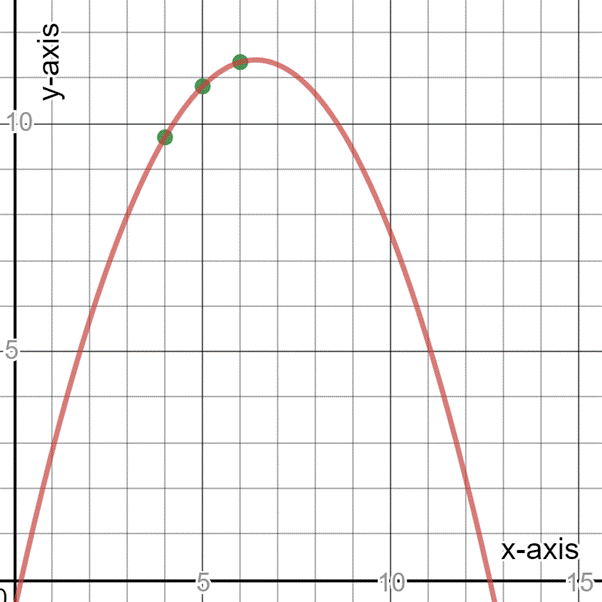
(a)
To Find: To find the equation of parabola from given information.
(a)
Answer to Problem 64E
The equation is
Explanation of Solution
Given information:Equation of parabola
Formula used: Matrix Algebra.
Since t represent the year with
Therefore,
| 4 | 9.697 |
| 5 | 10.816 |
| 6 | 11.347 |
Also, the given equation of parabola is
Put
Put
Put
Now, the given systems of equations are
Let
Such that,
Where
Calculation of determinant and cofactors of matrix A
Thus,
Now,
Thus, the values are
Hence the required parabolic equation is
(b)
To Graph: To graph the given equation.
(b)
Explanation of Solution
Given information:Given
| Year | Travellers (in thousands) |
| 2014 | 9.697 |
| 2015 | 10.816 |
| 2016 | 11.347 |
Graph:

Interpretation:
From the graph, the x-axis shows the year x and y-axis shows yearly travellers in thousands. Also, it can be seen that given
(c)
To Find: To find the number of travellers from 2017 to 2020
(c)
Answer to Problem 64E
The answer is
| Year | International travellers in thousands |
| 2017 | 11.29 |
| 2018 | 10.645 |
| 2019 | 9.412 |
| 2020 | 7.621 |
Explanation of Solution
Given information:Given
Calculation:
Since given equation is
Put
In 2017, the number of travellers will be 11.29 thousand
Similarly, put
In 2018, the number of travellers will be 10.645 thousand
Put
In 2019, the number of travellers will be 9.412 thousand
Put
In 2020, the number of travellers will be 7.621 thousand
(d)
To Explain:The above results are reasonable or not.
(d)
Explanation of Solution
Given information:Given equation
By comparing the graph and the table, it can be clearly seen that the number of international travellers declined from 2017.
Thus, the given answers are reasonable.
Chapter 7 Solutions
PRECALCULUS W/LIMITS:GRAPH.APPROACH(HS)
- Force with 800 N and 400 N are acting on a machine part at 30° and 60°, respectively with a positive x axis, Draw the diagram representing this situationarrow_forwardI forgot to mention to you to solve question 1 and 2. Can you solve it using all data that given in the pict i given and can you teach me about that.arrow_forwardexam review please help!arrow_forward
 Calculus: Early TranscendentalsCalculusISBN:9781285741550Author:James StewartPublisher:Cengage Learning
Calculus: Early TranscendentalsCalculusISBN:9781285741550Author:James StewartPublisher:Cengage Learning Thomas' Calculus (14th Edition)CalculusISBN:9780134438986Author:Joel R. Hass, Christopher E. Heil, Maurice D. WeirPublisher:PEARSON
Thomas' Calculus (14th Edition)CalculusISBN:9780134438986Author:Joel R. Hass, Christopher E. Heil, Maurice D. WeirPublisher:PEARSON Calculus: Early Transcendentals (3rd Edition)CalculusISBN:9780134763644Author:William L. Briggs, Lyle Cochran, Bernard Gillett, Eric SchulzPublisher:PEARSON
Calculus: Early Transcendentals (3rd Edition)CalculusISBN:9780134763644Author:William L. Briggs, Lyle Cochran, Bernard Gillett, Eric SchulzPublisher:PEARSON Calculus: Early TranscendentalsCalculusISBN:9781319050740Author:Jon Rogawski, Colin Adams, Robert FranzosaPublisher:W. H. Freeman
Calculus: Early TranscendentalsCalculusISBN:9781319050740Author:Jon Rogawski, Colin Adams, Robert FranzosaPublisher:W. H. Freeman
 Calculus: Early Transcendental FunctionsCalculusISBN:9781337552516Author:Ron Larson, Bruce H. EdwardsPublisher:Cengage Learning
Calculus: Early Transcendental FunctionsCalculusISBN:9781337552516Author:Ron Larson, Bruce H. EdwardsPublisher:Cengage Learning





